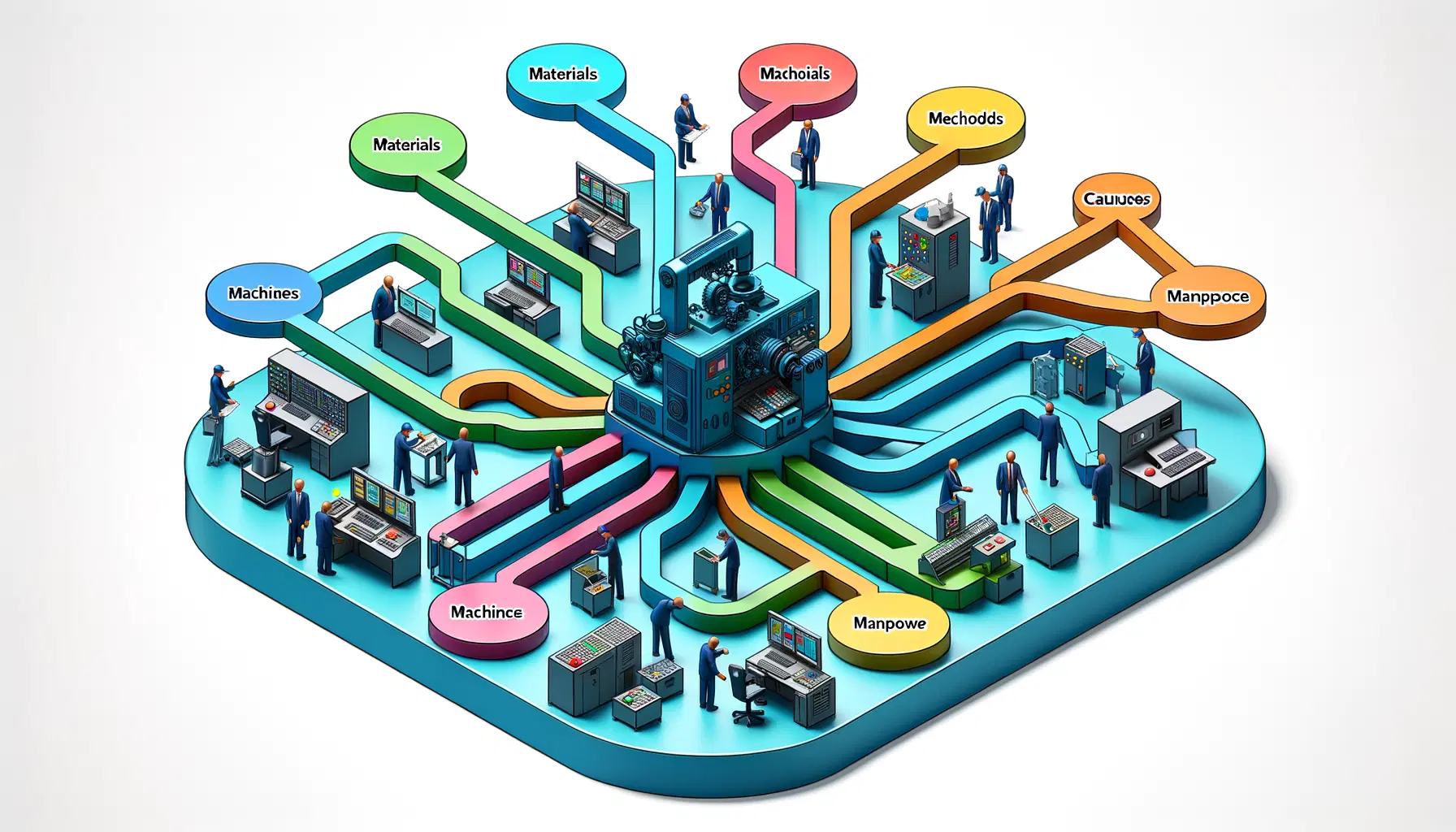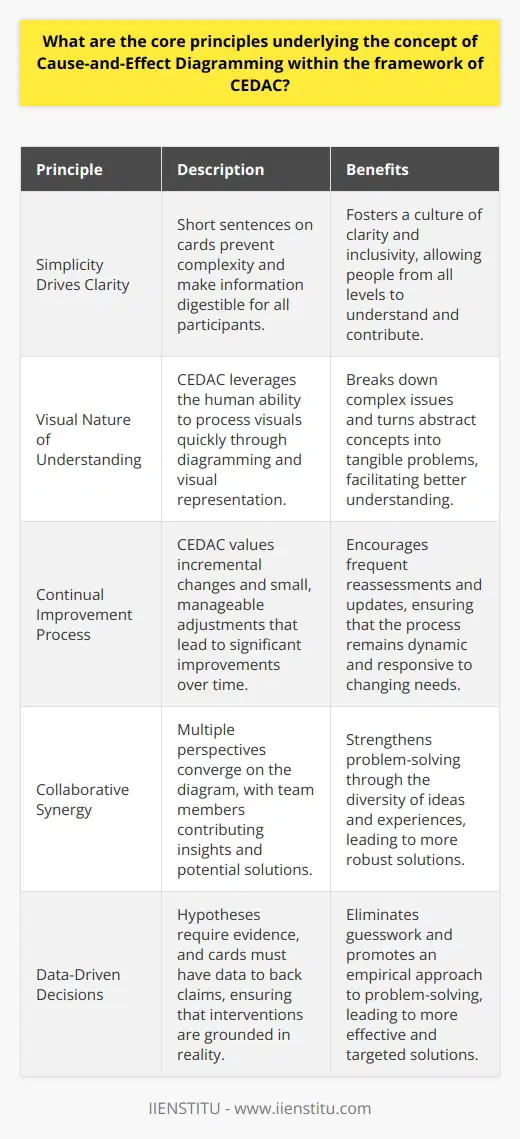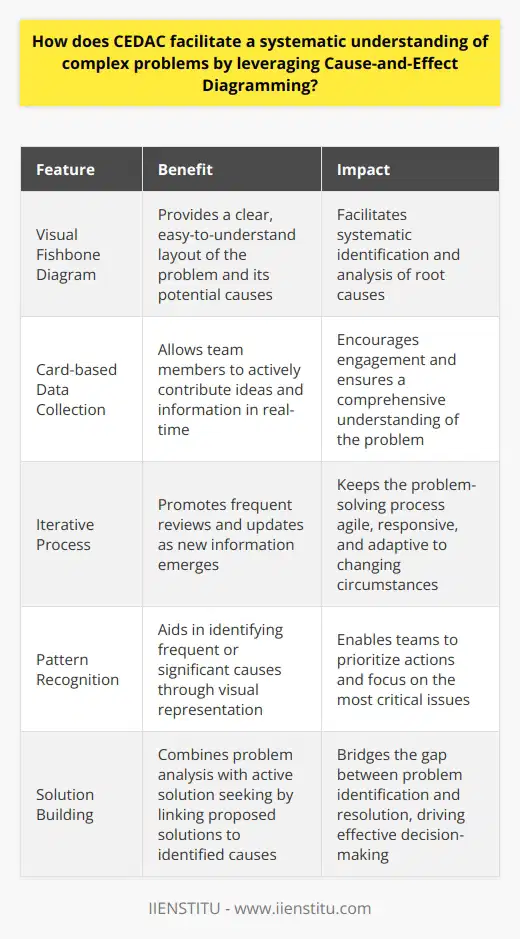
The concept of Cause-and-Effect Diagram with the Addition of Cards (CEDAC) is integral to rigorous problem-solving analysis. In this blog post, we will embark on a comprehensive foray into the facets of CEDAC, delineating its importance in organizational problem-solving endeavours. Not only has CEDAC transformed the way in which problems are diagnosed and resolved, but it also remains a cornerstone for continuous improvement in various sectors.
Through examining its historical development, understanding its components, and discussing its practical applications, we aim to address the significance of this tool in facilitating effective problem-solving and decision-making. Additionally, this exploration will delve into the future of CEDAC, reflecting on its relevance in today’s ever-evolving industries.
History and Development of CEDAC
The Concept's Formation and the People Behind CEDAC
CEDAC's origins trace back to the prolific work of Ryuji Fukuda, a Japanese expert in organizational management. Fukuda conceived CEDAC during his tenure at the Bridgestone Tire Company as a means to augment quality and efficiency.
His brainchild coalesced principles from existing quality management tools with innovative ideas, tailor-made to engage workers in problem-solving activities. Distinguished for its simplicity and efficacy, this system garnered widespread recognition and was embraced by entities across diverse industries.
Strategic Optimization To Boost Productivity Using The Pareto Principle
Essential Flow Charting Techniques For Effective Decision-making
Major Developmental Milestones
Following its inception, CEDAC underwent various developmental stages, punctuated by milestones that showcased its burgeoning influence. Academic endorsements, coupled with successful case study publications, accelerated its adoption on a global scale. The articulation of CEDAC into structured problem-solving skills training programs further established its status as a pivotal resource for organizational development.
CEDAC's Evolution in Response to Industry Needs
In its evolutionary journey, CEDAC has consistently adapted to accommodate the dynamic requirements of industry. Framework enhancements include digital integration and scalability modifications, ensuring that CEDAC remains a vital asset across various operational scopes. These evolutions, resonant with industry feedback and technological progress, have solidified CEDAC's position in the modern era of management tools.
Understanding the Components of CEDAC
Detailed Explanation of the Cause-and-Effect Diagram: The Cause-and-Effect Diagram, central to CEDAC, functions as an illustrative map that dissects complex problems into comprehensible components. Its importance lies in facilitating the identification of root causes by categorizing potential contributing factors. The benefits, extending from clarity in understanding to targeted action, are numerous. Constructing the diagram incorporates a procedure that calls for collaborative input, hypothesis generation, and iterative refinement.
Overview of the Addition of Cards: A unique aspect of CEDAC is the incorporation of 'cards', which are annotated with observations, ideas, or potential solutions and placed alongside relevant factors on the diagram. These cards encourage an ongoing, interactive discussion and progressively refine the understanding of the problem at hand. The interface between cards and the diagram paves the way for a participatory and dynamic problem-solving session.
Practical Examples of the Addition of Cards: The utilization of cards within CEDAC can be elucidated through real-life examples, where teams compile insights and possible countermeasures on cards, in response to identified problems. This technique has been pivotal in various contexts, such as manufacturing defect reduction and service delivery improvement, showcasing its versatility and effectiveness in enhancing operational outcomes.
The Process and Application of CEDAC
Step-by-Step Guide on Implementing CEDAC: The implementation of CEDAC is a structured process that begins with the articulation of the problem and culminates in the formulation of a plan of action. The sequential steps entail the construction of the Cause-and-Effect Diagram, the addition of cards through collective brainstorming, and the iterative exploration of identified issues until root causes are unambiguously pinpointed.
Description of Scenarios where CEDAC is Most Effective: CEDAC's applicability is wide-ranging, delivering results in scenarios as diverse as cross-functional project management and personal goal setting. Its utility is particularly pronounced in environments rife with complex, multifaceted challenges where traditional linear problem-solving falls short.
Case Studies Highlighting the Successful Use of CEDAC: Case studies serve as compelling endorsements for CEDAC's efficacy. For example, the deployment of CEDAC in a manufacturing context led to a marked reduction in process variations, enhancing product quality and customer satisfaction. Similarly, its application in healthcare resulted in improved diagnostic processes and patient care efficiency.
The Role of CEDAC in Decision Making and Problem-Solving: In the realm of decision-making, CEDAC stands out as a tool that drives empirical analysis and consensus-building. It supports a methodical approach to problem-solving that yields sustainable results and fosters a culture of proactive issue resolution within organizations.
The Advantages of CEDAC
Highlight of the Benefits of the Diagram: CEDAC's array of benefits includes but is not limited to enhanced team collaboration, heightened problem visibility, and augmented analytical acumen within organizations. These advantages converge to foster a comprehensive understanding of challenges and a sturdier foundation for pursuing solutions.
The Value of the Addition of Cards in Problem-Solving: The Addition of Cards within CEDAC further enriches the problem-solving paradigm by integrating diverse perspectives and generating a repository of collective intelligence. This aspect amplifies the inherent value of the diagram by ensuring that the process is inclusive and iterative.
How CEDAC Contributes to Efficiency and Productivity: With its emphasis on identifying and remedying root causes, CEDAC effectuates a reduction in recurrence of issues, thereby contributing to organizational efficiency and productivity. This proactive approach to problem identification and resolution ensures that systemic improvements are implemented, leading to long-term gains.
Common Challenges and Critics of CEDAC
Review of Potential Obstacles when Implementing CEDAC: Despite its proven effectiveness, CEDAC's implementation can encounter obstacles such as resistance to change, inadequate training, and a shortfall in management support. These challenges can impair the successful integration of the tool into an organization's problem-solving culture.
Discussion on Criticism and Controversy Related to CEDAC: Critics of CEDAC often point to its perceived complexity and the risk of becoming too engrossed in the process at the expense of action. Moreover, there is scrutiny over its applicability in environments that are highly unpredictable or less structured. Addressing these criticisms requires a nuanced understanding of CEDAC's intent and limitations.
Strategies to Overcome These Challenges: Organizations can overcome these challenges by committing to comprehensive online certificate course offerings, fostering a supportive culture for continuous improvement, and ensuring leadership is actively involved in promoting CEDAC principles. Adaptations to tailor CEDAC to specific organizational contexts can further enhance its adoption and utility.
Future Trends and Developments of CEDAC
Predicated Changes and Growth in CEDAC’s Stature: The future trajectory of CEDAC likely entails augmentation with advanced analytical tools, such as data mining and AI-driven predictive analytics. These technological advancements are poised to expand the depth and acuteness of CEDAC's problem-solving capabilities.
Influence of Technology on the Future of CEDAC: Technology's influence manifests through the digitization of diagrams and the integration of real-time data capturing, both of which are projected to elevate CEDAC's proficiency. As organizations strive to become more data-driven, CEDAC's fusion with technological aids underpins a synergistic evolution.
How Industries Should Prepare for These Trends: In preparation for these imminent developments, industries are encouraged to invest in workforce training, remain abreast of technological advancements, and adapt internal processes to accommodate more sophisticated iterations of CEDAC. Continuous learning and adaptability will be paramount in leveraging these emerging trends.
Frequently Asked Questions
What are the core principles underlying the concept of Cause-and-Effect Diagramming within the framework of CEDAC?
Understanding CEDAC's Core Principles
The Essence of Cause-and-Effect
CEDAC stands for Cause-and-Effect Diagram with the Addition of Cards. This method enhances problem-solving and communication within organizations. It builds upon the Ishikawa or fishbone diagram, but introduces an iterative process that incorporates the use of cards to capture suggestions and solutions.
Simplicity Drives Clarity
At its core, CEDAC champions simplicity. Short sentences on cards prevent complexity. They make the information digestible. People from all levels can participate and understand. This inclusive design fosters a culture of clarity.
Visual Nature of Understanding
Humans process visuals quickly. CEDAC leverages this through diagramming. Visual representation breaks down complex issues. It turns abstract concepts into tangible problems.
Continual Improvement Process
Improvement never stops in CEDAC. The approach values incremental changes. Small, manageable adjustments lead to significant improvements. The process encourages frequent reassessments and updates.
Collaborative Synergy
CEDAC thrives on collaboration. Multiple perspectives converge on the diagram. Team members contribute insights and potential solutions. This diversity strengthens problem-solving.
Empowerment through Ownership
Employees take ownership in CEDAC. They suggest, they decide. This empowerment fosters a deeper commitment to solutions. It also accelerates the implementation process.
Data-Driven Decisions
Hypotheses require evidence in CEDAC. Cards must have data to back claims. Guesswork has no place. This principle ensures interventions are grounded in reality.
Focused Problem-Solving
CEDAC emphasizes specific problems. Broad issues become tractable challenges. Focusing prevents overwhelming participants. It makes the action manageable and achievable.
Flexibility and Adaptability
While structured, CEDAC remains flexible. It adapts to different situations and problems. This adaptability makes it widely applicable. It can fit any organizational need.
In summary, CEDAC is a powerful tool that unites teams around shared problems, emphasizes continual learning, and promotes an empirical approach to organizational development. Understanding and applying these core principles enhances any problem-solving endeavor, ensuring that efforts are not only targeted and effective but also inclusive and adaptable.

How does CEDAC facilitate a systematic understanding of complex problems by leveraging Cause-and-Effect Diagramming?
Understanding CEDAC
Cause-and-Effect Diagram with the Addition of Cards (CEDAC) stands as a potent tool. It enables thorough comprehension of intricate problems. CEDAC extends beyond traditional cause-and-effect diagrams. It incorporates real-time data collection and idea generation. This drives a more dynamic problem-solving approach.
The Process
CEDAC fosters a structured, visual method. First, it identifies a specific problem or goal. Teams then brainstorm potential causes. They use cards to document these causes. The visual aspect of CEDAC creates an easy-to-understand layout. It aids in revealing the problem's roots systematically.
Engaging Teams
Teams actively contribute through card additions. They place cards on a diagram shaped like a fishbone. The diagram shows cause categories typically impacted by problems. These may include materials, methods, machines, and manpower. Thus, teams understand how various factors interrelate.
Dynamic Interaction
CEDAC stands out due to its iterative nature. It calls for frequent reviews and updates. Teams reassess cards as new information emerges. They relocate or remove cards to reflect deeper understanding. This keeps the problem-solving process agile and responsive.
Visual Clarity
The visual layout aids in pattern recognition. It aids in pinpointing frequent or significant causes. Teams can thus identify which causes warrant deeper investigation. They can prioritize actions efficiently.
Continuous Improvement
Another key feature of CEDAC is fostering continuous improvement. It nurtures a culture of ongoing inquiry and learning. Teams value each card as a piece of collective knowledge. Thus, learning accumulates over time through this systematic approach.
Real-time Solution Building
CEDAC bridges the gap between problem identification and resolution. It does this by combining analysis with active solution seeking. Teams propose solutions on new cards. They attach these to corresponding causes on the diagram. This ensures direct linkage between problems and solutions.
In conclusion, CEDAC offers a collaborative, visual, and iterative platform. It systematically dissects complex problems. Teams can thus explore and understand problems deeply. They can also align on effective solutions. This reinforces a culture of shared responsibility in problem-solving. It encourages engagement, clarity, and continuous improvement.

Can you provide practical illustrations where the application of Cause-and-Effect Diagramming within CEDAC led to significant improvement in problem-solving processes?
Understanding Cause-and-Effect Diagrams in CEDAC
Cause-and-Effect Diagramming plays a pivotal role in CEDAC. CEDAC stands for Cause-and-Effect Diagram with the Addition of Cards. It extends upon the basic Fishbone or Ishikawa diagram. The tool facilitates deeper problem analysis and encourages team collaboration. We explore practical examples of its effectiveness.
Real-Life Application in Manufacturing
A car manufacturer faced a high defect rate. The problem was complex and persistent. Managers summoned a cross-functional team. Members included engineers, line workers, and quality control staff. They employed CEDAC to address the issue.
The team sketched a basic fishbone diagram. They used cards to propose potential causes. Each card noted one idea for a cause of defects. They placed these cards along the diagram's "bones". The structured approach helped categorize the ideas. Categories included equipment, human error, and material quality.
Regular meetings ensued. Team members reviewed the diagram. They moved cards as their understanding improved. Over time, clear patterns emerged. Specific pieces of equipment caused the majority of issues. The team focused on these machines. They developed targeted maintenance plans. They also retrained operators. The defect rate dropped significantly.
Improving Healthcare Delivery
A hospital sought to reduce patient wait times. The emergency department consistently struggled with delays. Leaders formed a multidisciplinary team. It included doctors, nurses, and administrative staff. Cause-and-Effect Diagramming became the team's tool of choice.
The group constructed a CEDAC-based fishbone diagram. They identified several main categories. Staffing, processes, and patient flow were among them. Cards documented possible causes under each category. New ideas emerged. Discussions deepened the team's collective understanding.
The collaboration led to revelations. Ineffective scheduling was a major bottleneck. It caused cascading delays. Targeted interventions were developed. Hospital staff adjusted schedules. They also implemented a new triage system. Wait times decreased. Patient satisfaction saw measurable improvements.
Enhancing Customer Service in Retail
A retail chain had customer service complaints. Long checkout lines were a common grievance. The company convened a task force. Participants cut across various departments. Store layouts, staffing, and checkout processes faced scrutiny.
A CEDAC diagram guided the investigation. Teams listed possible causes on cards. Technology, staff training, and store policies were key focus areas. The cards enabled easy modifications to the diagram. They fostered a dynamic discussion process.
The analysis pointed to outdated point-of-sale systems. These systems slowed down transactions. Subsequently, the company upgraded its technology. Training programs were revised. Staff learned to assist customers more effectively. Checkout lines moved faster. Customer service scores improved. The bottom line saw a positive impact.
Conclusion
Cause-and-Effect Diagramming within CEDAC offers a structured, visual approach. It promotes team engagement. It helps distill complex problems into manageable parts. These real-world examples validate its effectiveness. Moreover, they showcase the versatility of CEDAC across various industries. It proves invaluable in enhancing problem-solving processes.



